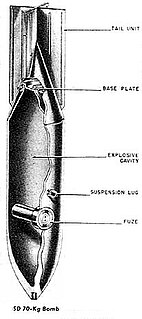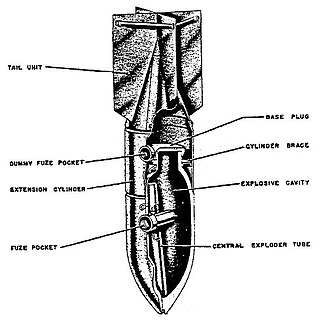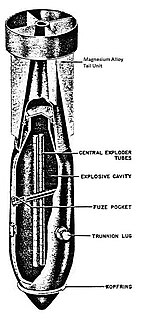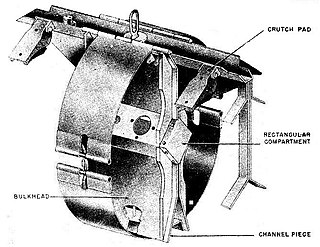
The Focke-Wulf Fw 200 Condor, also known as Kurier to the Allies, was a German all-metal four-engined monoplane originally developed by Focke-Wulf as a long-range airliner. A Japanese request for a long-range maritime patrol aircraft led to military versions that saw service with the Luftwaffe as long-range reconnaissance and anti-shipping/maritime patrol bomber aircraft. The Luftwaffe also made extensive use of the Fw 200 as a transport aircraft.

The Henschel Hs 129 was a World War II ground-attack aircraft fielded by the German Luftwaffe. The aircraft saw combat in Tunisia and on the Eastern Front.

An autocannon, automatic cannon or machine cannon is a fully automatic gun that is capable of rapid-firing large-caliber armour-piercing, explosive or incendiary shells, as opposed to the smaller-caliber kinetic projectiles (bullets) fired by a machine gun. Autocannons have a longer effective range and greater terminal performance than machine guns, due to the use of larger/heavier munitions, but are usually smaller than tank guns, howitzers, field guns or other artillery. When used on its own, the word "autocannon" typically indicates a non-rotary weapon with a single barrel. When multiple rotating barrels are involved, such a weapon is referred to as a "rotary autocannon" or occasionally "rotary cannon", for short.

R4M, abbreviation for Rakete, 4 kilogramm, Minenkopf, also known by the nickname Orkan due to its distinctive smoke trail when fired, was a folding-fin air-to-air rocket used by the Luftwaffe at the end of World War II.

The Messerschmitt Bf 110, often known unofficially as the Me 110, is a twin-engine Zerstörer, fighter-bomber, and night fighter (Nachtjäger) developed in Nazi Germany in the 1930s and used by the Luftwaffe during World War II. Hermann Göring was a proponent of the Bf 110, believing its heavy armament, speed, and range would make the Bf 110 the Luftwaffe’s premier offensive fighter. Early variants were armed with two MG FF 20 mm cannon, four 7.92 mm MG 17 machine guns, and one 7.92 mm MG 15 machine gun for defence. Development work on an improved type to replace the Bf 110 - the Messerschmitt Me 210 - began before the war started, but its teething troubles resulted in the Bf 110 soldiering on until the end of the war in various roles. Its intended replacements, the aforementioned Me 210 and the significantly improved Me 410 Hornisse never fully replaced the Bf 110.

Henschel's Hs 132 was a World War II dive bomber and interceptor aircraft of the German Luftwaffe that never saw service. The unorthodox design featured a top-mounted BMW 003 jet engine and the pilot in a prone position. The Soviet Army occupied the factory just as the Hs 132 V1 was nearing flight testing, the V2 and V3 being 80% and 75% completed.

The MG FF was a drum-fed, blowback-operated, 20 mm aircraft autocannon, developed in 1936 by Ikaria Werke Berlin of Germany. It was a derivative of the Swiss Oerlikon FF F cannon, with the Oerlikon FF design itself a development of the Imperial German World War I Becker 20 mm cannon, and was designed to be used in space-limited, fixed mountings such as inside aircraft wings, although it saw use as both an offensive and a defensive weapon, in both fixed and flexible format. It saw widespread use in those roles by the German Luftwaffe, particularly during the early stages of World War II, although from 1941 onwards it was gradually replaced by the Mauser firm's 20 mm MG 151/20, which was lighter, and had both a higher rate of fire and muzzle velocity.

A mine shell, also known as High-Explosive, High-Capacity (HEHC) in British military nomenclature, is a military explosive shell type characterized by thin shell walls and a correspondingly high quantity of explosives, much higher than the traditional high explosive shell type per caliber, meaning that mine shells trade fragmentation effect for a higher pressure wave effect when comparing to traditional high explosive shells.

The AB 250-2(Abwurfbehälter) was a cluster bomb used by the Luftwaffe during World War II.

The SD 50 or thick walled explosive bomb in English was a fragmentation bomb used by the Luftwaffe during World War II.

The SD 70 or thick walled explosive bomb in English was a fragmentation bomb used by the Luftwaffe during World War II.

The SD 250 or thick walled explosive bomb in English was a fragmentation bomb used by the Luftwaffe during World War II.

The SD 1700 or thick walled explosive bomb in English was a fragmentation bomb used by the Luftwaffe during World War II.

The PC 500 or cylindrical armor-piercing explosive bomb in English was a series of armor-piercing bombs used by the Luftwaffe during World War II.

The PC 1000 or cylindrical armor-piercing explosive bomb in English was an armor-piercing bomb used by the Luftwaffe during World War II.

The SD 15 or thick walled explosive bomb in English was a fragmentation bomb used by the Luftwaffe during World War II.

The AB 500-3A(Abwurfbehälter) was a cluster bomb used by the Luftwaffe during World War II.

The AB 500-1B(Abwurfbehälter) was a cluster bomb used by the Luftwaffe during World War II.

















